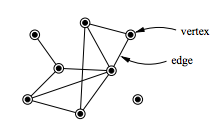Vertex (graph theory)
In graph theory, a vertex (plural: vertices) or node is one of the fundamental units of which graphs are formed. A graph is a collection of vertices connected by edges. Vertices are often used to represent entities in various applications, such as computer networks, social networks, and transportation systems.
Definition[edit | edit source]
A vertex is an element of a set \( V \) in a graph \( G = (V, E) \), where \( V \) is the set of vertices and \( E \) is the set of edges. Each edge in \( E \) is a pair of vertices, indicating a connection between them.
Types of Vertices[edit | edit source]
Vertices can be classified based on their properties and the structure of the graph:
- Isolated Vertex: A vertex with no incident edges.
- Pendant Vertex: A vertex with exactly one incident edge.
- Adjacent Vertices: Two vertices connected by an edge.
- Degree of a Vertex: The number of edges incident to a vertex. In a directed graph, the degree is divided into in-degree and out-degree.
Applications[edit | edit source]
Vertices are used in various fields to model and solve problems:
- In computer science, vertices can represent data points in data structures like trees and linked lists.
- In social network analysis, vertices represent individuals or entities, and edges represent relationships or interactions.
- In transportation networks, vertices can represent locations such as cities or intersections, with edges representing routes or connections.
Graph Representations[edit | edit source]
Graphs can be represented in multiple ways, with vertices being a key component:
- Adjacency List: Each vertex has a list of adjacent vertices.
- Adjacency Matrix: A matrix where rows and columns represent vertices, and entries indicate the presence or absence of edges.
- Incidence Matrix: A matrix where rows represent vertices and columns represent edges, with entries indicating the incidence relationship.
Related Concepts[edit | edit source]
- Edge (graph theory)
- Graph (discrete mathematics)
- Path (graph theory)
- Cycle (graph theory)
- Connected graph
- Complete graph
- Subgraph
See Also[edit | edit source]
- Graph theory
- Edge (graph theory)
- Adjacency matrix
- Incidence matrix
- Tree (graph theory)
- Network theory
| Graph theory | ||||||||||
|---|---|---|---|---|---|---|---|---|---|---|
This graph theory-related article is a stub. You can help WikiMD by expanding it.
|
This article is a mathematics-related stub. You can help WikiMD by expanding it!
Search WikiMD
Ad.Tired of being Overweight? Try W8MD's physician weight loss program.
Semaglutide (Ozempic / Wegovy and Tirzepatide (Mounjaro / Zepbound) available.
Advertise on WikiMD
|
WikiMD's Wellness Encyclopedia |
| Let Food Be Thy Medicine Medicine Thy Food - Hippocrates |
Translate this page: - East Asian
中文,
日本,
한국어,
South Asian
हिन्दी,
தமிழ்,
తెలుగు,
Urdu,
ಕನ್ನಡ,
Southeast Asian
Indonesian,
Vietnamese,
Thai,
မြန်မာဘာသာ,
বাংলা
European
español,
Deutsch,
français,
Greek,
português do Brasil,
polski,
română,
русский,
Nederlands,
norsk,
svenska,
suomi,
Italian
Middle Eastern & African
عربى,
Turkish,
Persian,
Hebrew,
Afrikaans,
isiZulu,
Kiswahili,
Other
Bulgarian,
Hungarian,
Czech,
Swedish,
മലയാളം,
मराठी,
ਪੰਜਾਬੀ,
ગુજરાતી,
Portuguese,
Ukrainian
Medical Disclaimer: WikiMD is not a substitute for professional medical advice. The information on WikiMD is provided as an information resource only, may be incorrect, outdated or misleading, and is not to be used or relied on for any diagnostic or treatment purposes. Please consult your health care provider before making any healthcare decisions or for guidance about a specific medical condition. WikiMD expressly disclaims responsibility, and shall have no liability, for any damages, loss, injury, or liability whatsoever suffered as a result of your reliance on the information contained in this site. By visiting this site you agree to the foregoing terms and conditions, which may from time to time be changed or supplemented by WikiMD. If you do not agree to the foregoing terms and conditions, you should not enter or use this site. See full disclaimer.
Credits:Most images are courtesy of Wikimedia commons, and templates, categories Wikipedia, licensed under CC BY SA or similar.
Contributors: Prab R. Tumpati, MD


